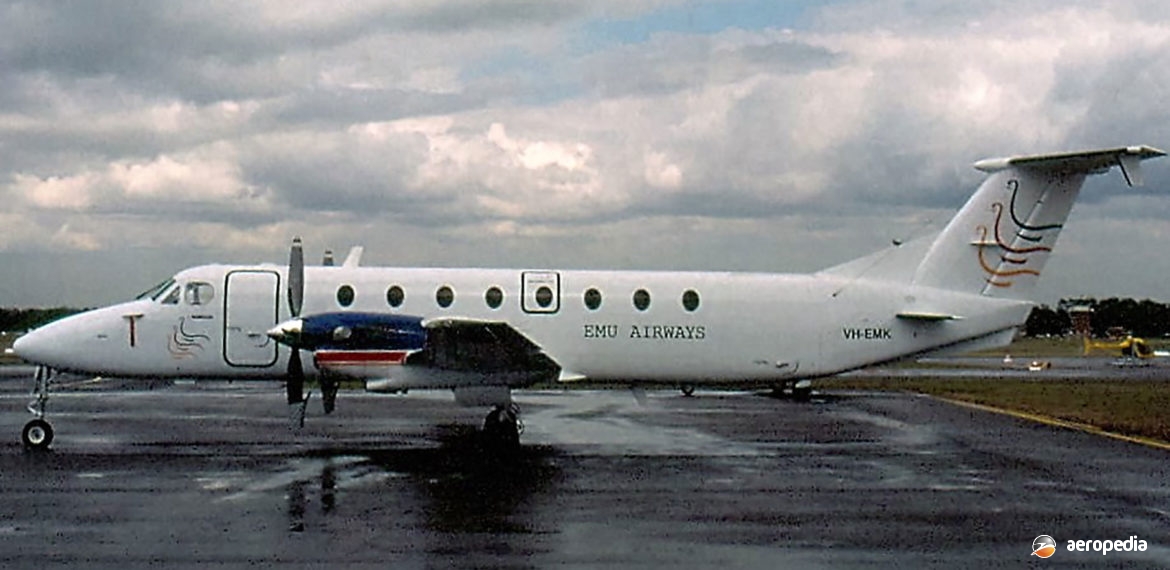Photograph:
Beech 1900C VH-EMK (c/n UC-159) at Bankstown, NSW in November 2000 (David C Eyre)
Country of origin:
United States of America
Description:
Commuter airliner
Power Plant:
Two 746 kw (1,000 shp) flat-rated Pratt & Whitney Canada PT6A-65B turboprops
Specifications:
- Wingspan: 16.61 m (54 ft 6 in)
- Length: 17.63 m (57 ft 10 in)
- Height: 4.53 m (14 ft 10¾ in)
- Wing area: 28.15 m² (303 sq ft)
- Max cruising speed at 2,440 m (8,000 ft): 474 km/h (295 mph)
- Max cruising speed at 4,875 m (16,000 ft): 436 km/h (271 mph)
- Stalling speed: 137 km/h (85 mph)
- Service ceiling: 9,144 m (30,000 ft)
- Rate of climb at sea level: 710 m/min (2,330 ft/min)
- Range at max cruising speed with max fuel and 45 mins reserve at 2,440 m (8,000 ft): 984 km (611 miles)
- Range at 7,620 m (25,000 ft): 1,469 km (913 miles)
- Range at economical cruising speed at 2,440 m (8,000 ft): 1,104 km (686 miles)
- Empty weight: 3,946 kg (8,700 lb)
- Loaded weight: 7,530 kg (16,600 lb)
History:
The Beech 1900 was a 19 passenger and crew of two pressurised airliner based on the Beech 200 Super King Air. Similar but larger than the Beech 99, the 1900 featured a stretch of the fuselage by 4.26 m (14 ft), new engines, and some interesting aerodynamic features for stability purposes. Variants offered at first included the 1900 Commuter, the 1900C with a large cargo door at the rear for freight work, and the executive model with 12 seats in two club-style sections separated by a galley in the middle of the cabin. Quick release seats permitted conversion from passenger to cargo configuration in 20 minutes.
The prototype (N1900A) made its first flight at Beech Field, Wichita, Kansas, USA on 3 September 1982, the second prototype following a month later, certification being received on 22 November 1983. Engines were the Pratt & Whitney PT6A-65B reverse-flow free-shaft turboprops rated at 746 kw (1,000 shp) up to 1,524 m (5,000 ft) driving three-blade Hartzell composite propellers. Beech offered two basic models initially, the commuter airliner and an executive variant, as noted. A maritime-patrol variant was also offered.
In the commuter airliner role, to allow for quick turn-around, the 1900C had single-point refuelling and two airstair doors. Range was 1,574 km (978 miles) with full fuel and passengers, allowing for 222 km (138 miles) stages to be flown without refuelling. Baggage space was 3.56 m³ (126 cub ft) and more than 680 kg (1,500 lb) could be carried. Beech also designed and built an upwards-opening cargo door for freight operations.
Production aircraft were built at Wichita, Kansas. Initial production was four aircraft a month, later increasing to eight. Production of the 1900C concluded in 1991 in favour of the 1900D, a total of 207 model 1900Cs having been delivered.
The first of the type seen in this area (N72351) arrived in late 1986, being a demonstrator for Hawker Pacific of Bankstown, NSW, the local distributor. Subsequently another arrived and was expected to go to Hazelton Airlines based at Cudal, NSW but due to certification problems the airline did not take delivery and the aircraft was sold overseas. In late 1989 a further 1900C arrived, becoming VH-JHP (c/n UC-31) on 29 March 1989 and entering service with Hazelton Airlines, initially on the Sydney – Albury, NSW and Sydney – Broken Hill, NSW routes. Subsequently it had a number of operators, for a period operating in South Australia with Sky Link on the Port Lincoln, Whyalla and Kingscote services until exported overseas.
Impulse Airlines imported and operated one 1900C, VH-AFR, later becoming VH-OST (c/n UC-56) in September 1994. Other operators of the 1900C have included Great Western Aviation in WA in 2001 with VH-IYP (c/n UB-620); Vincent Aviation which imported a 1900C VH-FWA (c/n UB-61) in June 1996; and Pel Air which imported and operated VH-AFR² (c/n UC0112). Other Beech 1900Cs registered include: VH-EMI (c/n UC-109), VH-EEY (c/n UC-130), and VH-EMK (c/n UC-159).
Beech 1900C VH-EMI4 (c/n UC-109 – ex A53-001, VH-EMI, N109YV, F-GPYU, N109YV) returned to the Australian Civil Aircraft Register in March 2016 after a period of operations by the Australian military as A53-001. The aircraft at that time operated with an AngelFire Electro Optical Wide Angle Aerial Surveillance System, a PicoSAR Synthetic Aperture Radar System, and a MX-20 L3 Wescam Electro Optical / Infrared sensor turret.
In 2001 Vincent Aviation in New Zealand imported VH-OST from Australia and it became ZK-VAE (c/n U-56) operating on NZ Defence Force commitments.

